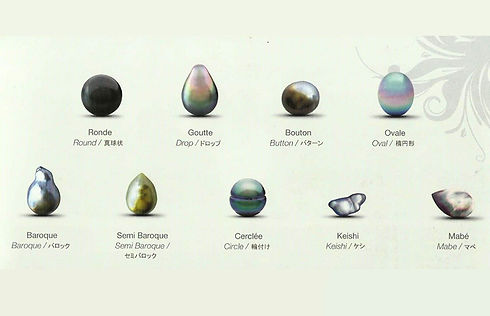
About The Type
The Tahitian pearl is an organic gem formed from the black lip oyster. These pearls derive their name from the fact that they are primarily cultivated around the islands of French Polynesia, around Tahiti.
This oysters are usually 6 to 12 inches in diameter and produce large pearls. It is a kind that very sensitive to the pearl culturing process, which makes the pearls very costly to produce. A true black Tahitian pearl is extremely rare, and largely considered one of the most beautiful kinds of pearls in the world. They were once so rare that they were considered the 'Pearl of Queens'.

About The Color
Tahitian Pearls are traditionally called "black pearls", but their color can range from a metallic silver, to the color of graphite. And within this range of colors they can have bluish, purplish, or greenish overtones. They can contain various undertones and overtones of green, pink, blue, silver and yellow. All (or any combination) of these colors may be seen in a cultured Tahitian pearl.
In the industry, specific names have been given to these overtone colors:
peacock — greenish black
cherry/aubergine — purplish black
champagne — yellowish gray
pistachio — greenish gray
lavender — bluish black
Tahitian gold — golden black
silver — gray

About The Size
Tahitian Pearls are arranged according to size by passing them through sieves. They are measured at their narrowest diameter. Most have a diameter measuring between 8mm and 14mm. A few exceptional ones reach between 15mm and 18mm and they are rare to found with perfect quality.

About The Shape
The cultured Tahitian pearl comes in various shapes, including round, semi-round, drop, button, circle, semi-baroque and baroque. Tahitian keshi and Tahitian mabe are also from black-tip oyster, which are in a small scale.
Round pearls must be an almost perfect sphere with less than 2% variation in diameter measurements. Because pearls grow for 18 months to 2 years inside an oyster, it is unusual to have perfectly spherical nacre. It is rare to have 10% of actual rounds from a crop, and they are usually only about 5% of harvesting.

About
The Imperfection
The Tahitian system for grading Tahitian black pearls has been developed by the Polynesian Government. It rates them from A to D. Any pearls lower than D are not allowed to be exported and are used to make pearl powder.
Quality A pearls have a good luster and are completely smooth, or show one or two tiny ripples or indentations that are visible to the naked eye. These affect less than 10% of the surface. Top quality pearls are very rare and expensive. DANNI WU PEARLS only sells Quality A pearls.

Pearl Care
Keep your pearls in top condition by limiting their exposure to acids and other chemicals. Avoid doing sports or cooking while wearing pearls. Gently wipe your pearls with a soft cloth after you remove them for the day. A pearl's luster can be damaged by even the smallest amount of perspiration. Removing your sweat from the pearls after each use helps preserve their luster.
Store your pearls in a manner that prevents them from getting scratched. Keep them separate from other pieces of jewelry, and avoid excessively dry conditions.
